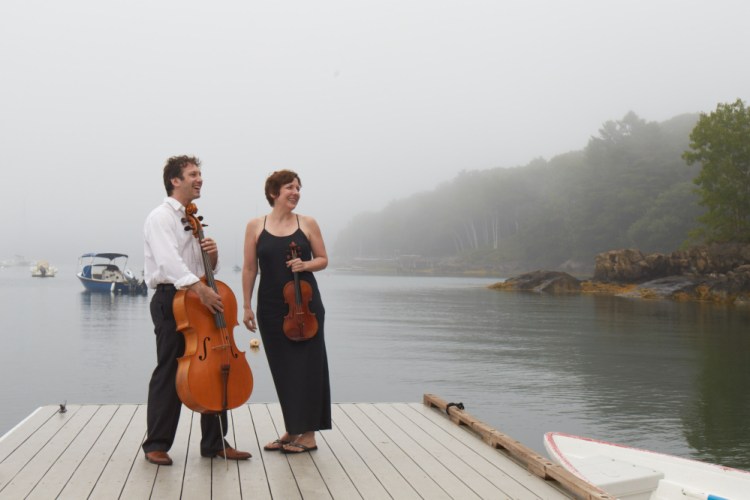Go out to eat in a restaurant, and chances are some kind of music will be playing in the background, whether it’s Beethoven or Bono.
Sometimes that music is distracting. Sometimes it enhances the dining experience.
Musicians Tracey Jasas-Hardel and Ben Noyes, founders of the Abitare Project, have taken this food-music relationship to the next level, pairing food with classical music the way a sommelier pairs wine with different courses.
This Sunday, Jasas-Hardel, a violinist, and Noyes, a cellist, will join Ali Waks Adams, executive chef at the Brunswick Inn, at the Robinhood Free Meetinghouse in Georgetown, to perform an intertwined concert and menu designed to delight all the senses.
It’s one of a series of events they’ve been holding around southern Maine. Each course will be accompanied by a companion piece from various composers. The second course of fusilli pasta with Maine squid, lobster and clams, for example, will be served while the musicians play the fourth movement of Maurice Ravel’s Sonata for Violin and Cello.
Jasas-Hardel says musicians and chefs use similar language to describe their work, using words such as light and dark, sharp or soft. Chefs and musicians both talk about color, volume and texture, she said.
“We’ll decide this passage needs to be rich and chocolaty, and this passage needs to be light like chiffon, or warm and smooth, so hopefully when we play it for people they get that from us,” Jasas-Hardel said. “They might not know the word for it, but when you put the food with it, they kind of get it.”

Violinist Tracey Jasas-Hardel and cellist Ben Noyes will play Sunday at the Robinhood Free Meetinghouse in Georgetown. The music-food pairing is one of several events they’re holding around southern Maine.
Jasas-Hardel recently spoke with the Press Herald to better explain the concept:
Q: You believe that music should be enjoyed everywhere, not just in the concert hall. Is that why you started this project, or is there a deeper connection between music and food?
A: We definitely think there is a very strong connection between music and food. When you go to a great restaurant with a great chef cooking, they really get into the senses, right? You see the food, you smell the food, you taste the food, and you feel the food in your mouth. And then you’ve sometimes got this random music playing in the background, and sometimes that can even be distracting. So we thought, what if it actually belonged there? What would happen?
What happened was shocking even to us. People were so involved with the food and they were involved with the music, and it brought back memories for them. Everybody comes backstage and says, “Oh my gosh, when you did that, I remembered my grandma.” Then we realized that what we were doing was making classical music accessible. It gives them a language.
Q: You offer a range of music to the chef, who then chooses what will be played and creates a menu around it. How do you choose the music you’ll give the chef? And do you make menu suggestions, or leave it up to their inspiration?
A: We wanted this to be a real, creative collaboration. We go to them and we say, “What sort of thing are you envisioning?” and then we tell them what we were envisioning – really talk it out like that from the beginning. And different chefs have taken it in really different directions. We had one guy who really got into the academic history of each piece. He went to the library and worked with the time periods of the piece. That was really fascinating.
Q: How did that show up in the food? Did he make food from that period?
A: Yeah, he did. It was amazing. We played an old piece by a Hungarian composer (Duo for Violin and Cello, Opus 7 by Zoltán Kodály), and he found this ancient recipe for goulash.
We’ve had somebody think really artistically about it. They actually tried to get into the mind of the composer (Ravel) and (find) emotional content in the food. That was super intense as well. He listened to the piece (the Sonata for Violin and Cello), and he did a little bit of research, and tried to figure out, what was this composer thinking and feeling? Why is this piece filled with opposites? To him the music actually felt black and white, which was interesting to us. He looked and found out the composer’s life was full of opposing forces. His mother was Basque and his father was French, he was gay but he lived as a straight man, all these opposites. So he made this buffet of black and white – white seafood splashed with squid ink, stuff like that. It was very artistic, and people really got the emotion from that.
Q: Would the same kind of project work with other forms of art, like painting or sculpture, or is the participation of the diner a necessary part of the experience?
A: I do think that it would work with art for sure. You could pair food and art, which people have done. You can pair music and art, which is definitely done all around the world. The fabulous thing is when you start bringing together these different art forms, it appeals to more senses at one time, and it makes everything more accessible.
Send questions/comments to the editors.




Comments are no longer available on this story